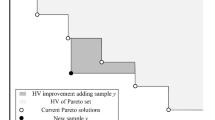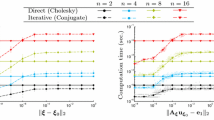Abstract
The problem of locating a contour widely exists in the engineering product design, such as the constrained optimization problem, reliability analysis, and so on. The surrogate model-assisted contour prediction methods have gained more attention lately because they can alleviate the computational burden significantly compared with the traditional simulation-based approaches. Representatively, the method built on the expected improvement (EI) infill criterion can allocate a contour from expensive simulations by refining the Kriging model with high-fidelity (HF) samples sequentially. Recently, the multi-fidelity (MF) Kriging model has gained remarkable attention because it integrates the accurate but costly HF model and cheap but biased low-fidelity (LF) model to provide an accurate prediction of the original black-box system. To facilitate the usage of the MF Kriging model in the contour prediction, a novel sequential multi-fidelity surrogate model-assisted contour prediction method is developed in this work. First, an extended expected improvement (EEI) infill criterion is developed to overcome the shortcoming of the original EI criterion on determining the locations and fidelity level of new samples. The developed EEI criterion can quantify the improvement of a sample from different fidelities over the contour of interest by considering the relative correlation between different fidelities. Second, considering the significant effect of the high-to-low simulation cost ratio on the MF Kriging model, the proposed approach selects an HF sample or several LF samples with equivalent computational resources to refine the MF Kriging model in each cycle according to their total improvements to the contour of interest. To this end, the EEI criterion is further revised combining a parallel strategy to generate the LF samples. The performance of the proposed approach is tested on three numerical examples with different complexities and an engineering case. The results show that the proposed approach has better efficiency, prediction accuracy, and robust performance compared with several state-of-the-art methods.
















Similar content being viewed by others
References
Zhou Q, Wu J, Xue T, Jin P (2019) A two-stage adaptive multi-fidelity surrogate model-assisted multi-objective genetic algorithm for computationally expensive problems. Eng Comput. https://doi.org/10.1007/s00366-019-00844-8
Truong V-H, Kim S-E (2017) An efficient method of system reliability analysis of steel cable-stayed bridges. Adv Eng Softw 114:295–311. https://doi.org/10.1016/j.advengsoft.2017.07.011
Xiao N, Zuo M, Guo W (2018) Efficient reliability analysis based on adaptive sequential sampling design and cross-validation. Appl Math Model 58:404–420. https://doi.org/10.1016/j.apm.2018.02.012
Punzo A, Blostein M, McNicholas PD (2020) High-dimensional unsupervised classification via parsimonious contaminated mixtures. Pattern Recognit. https://doi.org/10.1016/j.patcog.2019.107031
Shi R, Liu L, Long T, Wu Y, Tang Y (2019) Filter-based adaptive Kriging method for black-box optimization problems with expensive objective and constraints. Comput Methods Appl Mech Eng 347:782–805. https://doi.org/10.1016/j.cma.2018.12.026
Cheng K, Lu Z (2020) Structural reliability analysis based on ensemble learning of surrogate models. Struct Saf 83:101905. https://doi.org/10.1016/j.strusafe.2019.101905
Tamimi S, Amadei B, Frangopol DM (1989) Monte Carlo simulation of rock slope reliability. Comput Struct 33(6):1495–1505. https://doi.org/10.1016/0045-7949(89)90489-6
Marques AN, Opgenoord MMJ, Lam RR, Chaudhuri A, Willcox KE (2020) Multifidelity method for locating aeroelastic flutter boundaries. AIAA J 58(4):1772–1784. https://doi.org/10.2514/1.J058663
Trochu F (1993) A contouring program based on dual kriging interpolation. Eng Comput 9(3):160–177. https://doi.org/10.1007/BF01206346
Kleijnen JPC (2009) Kriging metamodeling in simulation: a review. Eur J Oper Res 192(3):707–716. https://doi.org/10.1016/j.ejor.2007.10.013
Gutmann HM (2001) A radial basis function method for global optimization. J Glob Optim 19(3):201–227. https://doi.org/10.1023/A:1011255519438
Sacks J, Welch WJ, Mitchell TJ, Wynn HP (1989) Design and analysis of computer experiments. Stat Sci 4(4):409–423
Parnianifard A, Azfanizam AS, Ariffin MKA, Ismail MIS (2019) Crossing weighted uncertainty scenarios assisted distribution-free metamodel-based robust simulation optimization. Eng Comput 36(1):139–150. https://doi.org/10.1007/s00366-018-00690-0
Smola AJ, Schölkopf B (2004) A tutorial on support vector regression. Stat Comput 14(3):199–222
Liu H, Ong Y-S, Cai J (2017) A survey of adaptive sampling for global metamodeling in support of simulation-based complex engineering design. Struct Multidiscip Optim 57(1):393–416. https://doi.org/10.1007/s00158-017-1739-8
Qian J, Yi J, Cheng Y, Liu J, Zhou Q (2019) A sequential constraints updating approach for Kriging surrogate model-assisted engineering optimization design problem. Eng Comput. https://doi.org/10.1007/s00366-019-00745-w
Ranjan P, Bingham D, Michailidis G (2008) Sequential experiment design for contour estimation from complex computer codes. Technometrics 50(4):527–541. https://doi.org/10.1198/004017008000000541
Jones D, Schonlau M, Welch W (1998) Efficient global optimization of expensive black-box functions. J Glob Optim 13:455–492
Bingham D, Ranjan P, Welch WJ (2014) Design of computer experiments for optimization, estimation of function contours, and related objectives. In: Statistics in action: a Canadian outlook. CRC Press, pp 109–124. https://doi.org/10.1201/b16597
Viana FAC, Haftka RT, Watson LT (2011) Sequential sampling for contour estimation with concurrent function evaluations. Struct Multidiscip Optim 45(4):615–618. https://doi.org/10.1007/s00158-011-0733-9
Bichon BJ, Eldred MS, Swiler LP, Mahadevan S, McFarland JM (2008) Efficient global reliability analysis for nonlinear implicit performance functions. AiAA J 46(10):2459–2468. https://doi.org/10.2514/1.34321
Echard B, Gayton N, Lemaire M (2011) AK-MCS: an active learning reliability method combining Kriging and Monte Carlo simulation. Struct Saf 33(2):145–154. https://doi.org/10.1016/j.strusafe.2011.01.002
Sun Z, Wang J, Li R, Tong C (2017) LIF: a new Kriging based learning function and its application to structural reliability analysis. Reliab Eng Syst Saf 157:152–165. https://doi.org/10.1016/j.ress.2016.09.003
Zhang X, Wang L, Sørensen JD (2019) REIF: a novel active-learning function toward adaptive Kriging surrogate models for structural reliability analysis. Reliab Eng Syst Saf 185:440–454. https://doi.org/10.1016/j.ress.2019.01.014
Roy S (2008) Sequential-adaptive design of computer experiments for the estimation of percentiles. The Ohio State University, Columbus
Roy S, Notz WI (2013) Estimating percentiles in computer experiments: a comparison of sequential-adaptive designs and fixed designs. J Stat Theory Pract 8(1):12–29. https://doi.org/10.1080/15598608.2014.840491
Park C, Haftka RT, Kim NH (2017) Remarks on multi-fidelity surrogates. Struct Multidiscip Optim 55(3):1029–1050. https://doi.org/10.1007/s00158-016-1550-y
Zhou Q, Jiang P, Shao X, Hu J, Cao L, Wan L (2017) A variable fidelity information fusion method based on radial basis function. Adv Eng Inform 32:26–39. https://doi.org/10.1016/j.aei.2016.12.005
Dong H, Song B, Wang P, Huang S (2014) Multi-fidelity information fusion based on prediction of Kriging. Struct Multidiscip Optim 51(6):1267–1280. https://doi.org/10.1007/s00158-014-1213-9
Han Z, Görtz S (2012) Hierarchical Kriging model for variable-fidelity surrogate modeling. AIAA J 50(9):1885–1896. https://doi.org/10.2514/1.J051354
Tie Y, Hou Y, Li C, Meng L, Sapanathan T, Rachik M (2020) Optimization for maximizing the impact-resistance of patch repaired CFRP laminates using a surrogate-based model. Int J Mech Sci. https://doi.org/10.1016/j.ijmecsci.2019.105407
Bandler JW, Cheng QS, Nikolova NK, Ismail MA (2004) Implicit space mapping optimization exploiting preassigned parameters. IEEE Trans Microw Theory Tech 52(1):378–385. https://doi.org/10.1109/TMTT.2003.820892
Sun G, Li G, Li Q (2012) Variable fidelity design based surrogate and artificial bee colony algorithm for sheet metal forming process. Finite Elem Anal Des 59:76–90. https://doi.org/10.1016/j.finel.2012.04.012
Jiang P, Cheng J, Zhou Q, Shu L, Hu J (2019) Variable-fidelity lower confidence bounding approach for engineering optimization problems with expensive simulations. AIAA J 57(12):5416–5430. https://doi.org/10.2514/1.J058283
Keane AJ, Sóbester A, Forrester AIJ (2007) Multi-fidelity optimization via surrogate modelling. Proc R Soc A Math Phys Eng Sci 463(2088):3251–3269. https://doi.org/10.1098/rspa.2007.1900
Kennedy MC, O’Hagan A (2000) Predicting the output from complex computer code when fast approximations are available. Biometrika 87(1):1–13
Forrester AIJ, Sóbester A, Keane AJ (2008) Engineering design via surrogate modelling a practical guide. Wiley, Hoboken
Shu L, Jiang P, Zhou Q, Shao X, Hu J, Meng X (2018) An on-line variable fidelity metamodel assisted Multi-objective Genetic Algorithm for engineering design optimization. Appl Soft Comput 66:438–448. https://doi.org/10.1016/j.asoc.2018.02.033
Chen R, Hung Y, Wang W, Yen S (2012) Contour estimation via two fidelity computer simulators under limited resources. Comput Stat 28(4):1813–1834. https://doi.org/10.1007/s00180-012-0380-7
Marques A, Lam R, Willcox K (2018) Contour location via entropy reduction leveraging multiple information sources. In: Advances in neural information processing systems, 2018, pp 5217–5227
Krige DG (1952) A statistical approach to some basic mine valuation problems on the witwatersrand. J Chem Metall Min Soc S Afr 52(6):119–139
Wang Z, Shafieezadeh A (2019) ESC: an efficient error-based stopping criterion for kriging-based reliability analysis methods. Struct Multidiscip Optim 59(5):1621–1637. https://doi.org/10.1007/s00158-018-2150-9
Chugh T, Sindhya K, Hakanen J, Miettinen K (2017) A survey on handling computationally expensive multiobjective optimization problems with evolutionary algorithms. Soft Comput 23(9):3137–3166. https://doi.org/10.1007/s00500-017-2965-0
Massaro A, Benini E (2015) A surrogate-assisted evolutionary algorithm based on the genetic diversity objective. Appl Soft Comput 36:87–100. https://doi.org/10.1016/j.asoc.2015.06.026
Stein M (1987) Large sample properties of simulations using Latin hypercube sampling. Technometrics 29(2):143–151
Huang D, Allen TT, Notz WI, Miller RA (2006) Sequential kriging optimization using multiple-fidelity evaluations. Struct Multidiscip Optim 32(5):369–382. https://doi.org/10.1007/s00158-005-0587-0
Liu Y, Chen S, Wang F, Xiong F (2018) Sequential optimization using multi-level cokriging and extended expected improvement criterion. Struct Multidiscip Optim 58(3):1155–1173. https://doi.org/10.1007/s00158-018-1959-6
Zhan D, Qian J, Cheng Y (2016) Pseudo expected improvement criterion for parallel EGO algorithm. J Glob Optim 68(3):641–662. https://doi.org/10.1007/s10898-016-0484-7
McKay MD, Beckman RJ, Conover WJ (1979) Comparison of three methods for selecting values of input variables in the analysis of output from a computer code. Technometrics 21(2):239–245. https://doi.org/10.1080/00401706.1979.10489755
Toal DJJ (2015) Some considerations regarding the use of multi-fidelity Kriging in the construction of surrogate models. Struct Multidiscip Optim 51(6):1223–1245. https://doi.org/10.1007/s00158-014-1209-5
Cai X, Wang L, Zhao Z, Zhao A, Zhang X, Wu T, Chen H (2016) The mechanical and acoustic properties of two-dimensional pentamode metamaterials with different structural parameters. Appl Phys Lett 109(13):1–5. https://doi.org/10.1063/1.4963818
Huang J, Gong X, Zhang Q, Scarpa F, Liu Y, Leng J (2016) In-plane mechanics of a novel zero Poisson's ratio honeycomb core. Compos B Eng 89:67–76. https://doi.org/10.1016/j.compositesb.2015.11.032
Hassani B, Hinton E (1998) A review of homogenization and topology optimization I—homogenization theory for media with periodic structure. Comput Struct 69(6):707–717. https://doi.org/10.1016/S0045-7949(98)00131-X
Acknowledgements
This work has been supported by the National Natural Science Foundation of China (NSFC) under Grant No. 51805179, the National Defense Innovation Program under Grant No. 18-163-00-TS-004-033-01, and the Research Funds of the Maritime Defense Technologies Innovation.
Author information
Authors and Affiliations
Corresponding author
Additional information
Publisher's Note
Springer Nature remains neutral with regard to jurisdictional claims in published maps and institutional affiliations.
Rights and permissions
About this article
Cite this article
Liu, J., Yi, J., Zhou, Q. et al. A sequential multi-fidelity surrogate model-assisted contour prediction method for engineering problems with expensive simulations. Engineering with Computers 38, 31–49 (2022). https://doi.org/10.1007/s00366-020-01043-6
Received:
Accepted:
Published:
Issue Date:
DOI: https://doi.org/10.1007/s00366-020-01043-6




